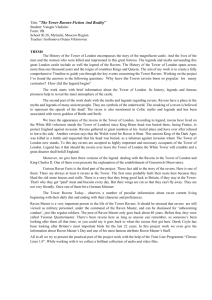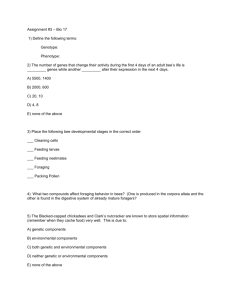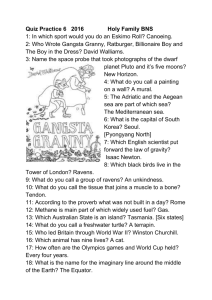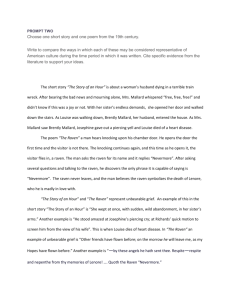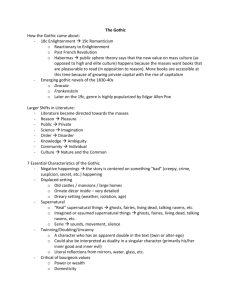On the Paradox of the Ravens
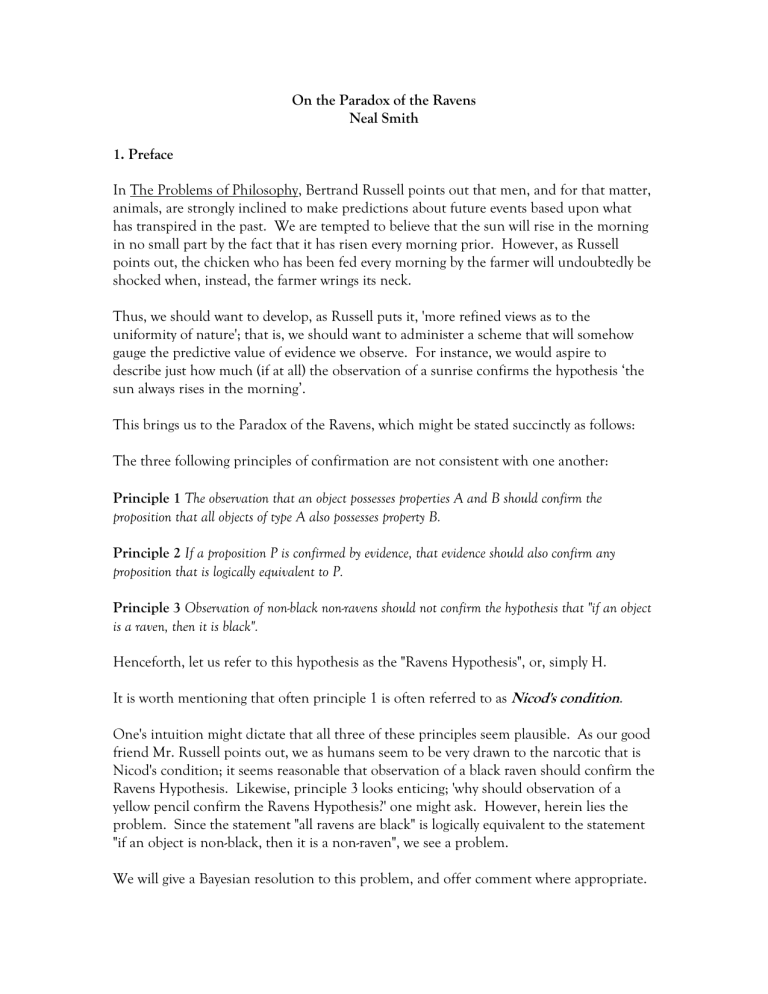
On the Paradox of the Ravens
Neal Smith
1. Preface
In The Problems of Philosophy, Bertrand Russell points out that men, and for that matter, animals, are strongly inclined to make predictions about future events based upon what has transpired in the past. We are tempted to believe that the sun will rise in the morning in no small part by the fact that it has risen every morning prior. However, as Russell points out, the chicken who has been fed every morning by the farmer will undoubtedly be shocked when, instead, the farmer wrings its neck.
Thus, we should want to develop, as Russell puts it, 'more refined views as to the uniformity of nature'; that is, we should want to administer a scheme that will somehow gauge the predictive value of evidence we observe. For instance, we would aspire to describe just how much (if at all) the observation of a sunrise confirms the hypothesis ‘the sun always rises in the morning’.
This brings us to the Paradox of the Ravens, which might be stated succinctly as follows:
The three following principles of confirmation are not consistent with one another:
Principle 1 The observation that an object possesses properties A and B should confirm the
proposition that all objects of type A also possesses property B.
Principle 2 If a proposition P is confirmed by evidence, that evidence should also confirm any
proposition that is logically equivalent to P.
Principle 3 Observation of non-black non-ravens should not confirm the hypothesis that "if an object is a raven, then it is black".
Henceforth, let us refer to this hypothesis as the "Ravens Hypothesis", or, simply H.
It is worth mentioning that often principle 1 is often referred to as Nicod's condition.
One's intuition might dictate that all three of these principles seem plausible. As our good friend Mr. Russell points out, we as humans seem to be very drawn to the narcotic that is
Nicod's condition; it seems reasonable that observation of a black raven should confirm the
Ravens Hypothesis. Likewise, principle 3 looks enticing; 'why should observation of a yellow pencil confirm the Ravens Hypothesis?' one might ask. However, herein lies the problem. Since the statement "all ravens are black" is logically equivalent to the statement
"if an object is non-black, then it is a non-raven", we see a problem.
We will give a Bayesian resolution to this problem, and offer comment where appropriate.
2. A Bayesian approach
First, we will follow the lead of Horwich (1982), who examines the approach of Mackie
(1963), and give a Bayesian approach to resolution of the paradox.
For the purpose of this discussion, we will say that E confirms H if and only if p ( H | E )
p ( H ) , i.e, p ( H | p ( H )
E )
1
.
We will also assume that some background knowledge K is present, but for ease of notation, we will always write p(H) in lieu of p(H|K), as no confusion will arise.
And, for the record, let us state one particular fact, which follows directly from Bayes'
Theorem. p ( E | H )
p ( H | E )
(1) p ( E ) p ( H )
Now, we are ready to proceed. We will assume that the relative frequency of occurrence of ravens in our universe is x, and the relative frequency of black objects is y. Further, we will make an assumption, namely, that x is very small, which seems plausible, based upon what seems to be the makeup of our universe.
It will be probably be easiest, as is usually the case, to present our assumptions about the makeup of the universe in a table below.
Table 1---assumptions about universe composition
B
R p(RB)=xy
~R
(1-x)y y
~B x(1-y) x
(1-x)(1-y)
1-x
1-y
Here, we use the notation B for "black object" and R for "raven object".
Now, if we condition on H, we obtain the following table.
Table 2---conditioning on H
B
~B
R p(RB|H)=x
0 x
~R y-x
1-y
1-x y
1-y
Here, we begin by establishing that if H is indeed true, we will have no non-black ravens, and thus, p(R~B|H)=0. The rest of the table can then be filled in as indicated above.
We then apply (1). We thus have p ( H | BR )
p ( BR | H )
x
1
(2) p ( H ) p ( BR ) xy y as well as p ( H |~ B p ( H )
~ R )
p (~ B p (~
~
B
R
~
| H )
R )
( 1
1
y x )( 1
y )
1
1
x
(3)
(2) and (3) tell us two very satisfying tidbits of information. (2) says that the observation of a black raven will indeed confirm H. A trivial (but interesting) observation is that if one presumes y is also small, as could be argued is true in our universe, H will substantially be
"beefed up" by this observation.
Moreover, (3) tells us that if we presume x is small, that the conformational value of observing a non-black non-raven is very slight, as in this case,
1
1
x
1
.
However, these very nice results do not come without a price. One mildly disturbing result that occurs is the fact that p ( H | B p ( H )
~ R )
p ( B ~ p ( B
R
~
| H )
R )
y
( 1
x x ) y
Observe that simple algebra yields y
( 1
x ) x y
1
y
x
( 1
x ) y
y
x
y
xy
xy
x
, and since we are assuming that y<1, that is, our universe contains some non-black objects, the latter inequality above must hold. That is, H is negatively confirmed by the observation of a black non-raven.
So, we have the somewhat undesirable (at least if we are to retain principle 3) result that H is confirmed, albeit slightly, by observation of a non-black non-raven, and negatively confirmed by the observation of a black non-raven. Horwich and Mackie are unwilling to waver on Principle 3; they maintain that the source of this apparent paradox is that Nicod's condition is in fact, false.
3. Defense of the failure of Nicod's condition; criticisms
If we wish to uphold this conviction, we must somehow explain away these problems. We will give two arguments; the first by Suppes (1966), in which he attempts to argue away the problem of observing a non-black non-raven. We will then give Horwich's account of the aforementioned problems.
First, again referring to Table 1, and applying the definition of conditional probability, we note that
P (~ B | R )
P (~ BR )
P ( R )
x ( 1
x ( 1
y ) y )
xy
(4) and that
P ( R |~ B )
P (~
P (~
BR )
B )
x ( 1
y ) x ( 1
( 1
y ) x )( 1
y )
(5)
From (4) and (5) we may deduce that
P (~ B | R )
P ( R |~ B )
( 1
x )( 1
y )
xy
(6) which as is, may not seem meaningful, but observe that the latter inequality holds if we believe that the probability of encountering a non-black non-raven is greater than the probability of encountering a black raven, which, from what we know of the makeup of our universe, seems safe.
Suppes asserts that from (6), we should come away with the idea that principle 3 is justified; that is, (6) tells us that we are more likely to find a counterexample to the Ravens
Hypothesis by sampling ravens then by sampling non-black objects.
However, as Earman (1992) points out, this conclusion is a bit shaky. He notes that, at first glance, Suppes' argument seems to be non-Bayesian in the sense that Suppes speaks only of "attempted falsifications" to the Ravens Hypothesis.
Horwich's argument has the advantage of trying to salvage Mackie's solution while still in a
Bayesian setting. He points out two flaws in Mackie's solution. First, if we glance at tables
1 and 2, we see that there is an implicit assumption that
P ( B | H )
P ( B ) and P ( R | H )
P ( R ) (7)
That is, Mackie assumes that proportions of black objects and of ravens are independent of
H, which Horwich asserts that there is no reason to believe.
Moreover, he argues that, in a similar vein to Earman's objection above, that there are many possible ways of gathering a black raven in support of H. One might pick a random object and find it is a black raven, or observe a randomly selected object from the class of black objects, and note that it is a raven, or observe a randomly selected object from the class of ravens, and note that it is black.
He claims that this subtle flaw is to blame in Mackie's solution to the problem. To elaborate, we will use his notation, letting P(R*B) and P(B*R) represent the probabilities that a randomly selected raven is found to be black and a randomly selected black object is found to be a raven.
However, Horwich asserts that sampling black objects is useless, in the sense that we may observe black objects to our heart's content, and not so much as jeopardize the Ravens hypothesis. He argues that to put H to the "toughest test" we would scrutinize ravens, and not black objects. Formally, we should consider the evidential values of these events, and see if they pass muster.
Note that
P ( R * B | H
P ( R * B )
)
proportion of R that is RB in table 2 proportion of R that is RB in table 1
1 xy x
1 y and similarly,
P ( B * R | H )
x y xy
1
P ( B * R ) y y
Thus, we see that in Mackie's account, R*B and B*R have the same evidential value, which
Horwich claims is preposterous.
Horwich proposes that we thus begin (almost) anew; that is, we can still salvage a Bayesian resolution to the problem within Mackie's general framework. Let us throw away (7), and restate our background assumptions.
Table 3---revised assumptions about composition of universe
B
~B
R
P(RB)=a c a+c
~R b d b+d a+b c+d
B
~B
Table 4---conditioning on H upon abandoning (7)
R
P(RB|H)= a'
0 a'
~R b' d' b'+d' a'+b' d'
Again, this time, we shall not assume either of the results in (7). We will not put any restrictions on the entries in tables 3 or 4, except that the entries are consistent with the fact that
P (
) and
P (
| H ) are probabilities.
If we apply Bayes' theorem, we see that
P ( H | BR )
P ( BR | H ) P ( H )
P ( BR )
a '
P ( H ) a
(8) and that
P ( H |~ B ~ R )
P (~ B ~ R | H ) P ( H )
d '
P ( H ) d
(9)
P (~ P ~ R )
As Horwich points out, if we discard our previous assumptions, we are not compelled to believe that a '
a
, or for that matter, that d '
d
. Thus, we are now saddled with the
(perhaps unsavory) conclusion that stumbling upon a black raven, or for that matter, a non-black non-raven need not have any evidential value whatsoever. However, he proposes that we press on, nonetheless.
As above, by the information in tables 3 and 4, and applying Bayes' theorem, we see that
P ( H | R * B )
P ( R * B
P ( R
| H ) P ( H
* B )
)
( 1 ) P ( H a a
c
)
a
a c
P ( H )
(10)
P ( H |~ B * ~ R )
P (~ B *
P (~
~ R
B *
|
~
H ) P ( H
R )
)
( 1 ) P ( H d d
c
)
d
d c
P ( H )
(11)
P ( H | B * R )
P ( B * R
P ( B
| H
*
)
R )
P ( H )
a ' a
' b ' P ( H )
(12) a a
b
At this point, the reader may pause, as does Earman. In (10) and (11) we wrote down that
P(R*B|H) = P(~B*~R|H) = 1. Earman notes that the former quantity is the probability that we opted to choose an object randomly from the class of ravens, and note its blackness, and this probability is not 1. To elucidate, we will now follow Earman's notation. Let R*a denote the event that a is drawn randomly from the class of ravens, and let R*b stand for the event that b was drawn from the class of non-black objects (and we will say Ba is the event that a is found to be black, and Rb is the event that b is found to be a raven).
Earman points out that if we now apply Bayes' theorem, we will find that
P ( H | R * a
Ba )
P ( H )
P ( R *
P ( R a
*
a
Ba
|
Ba
H
)
) and that
P ( H |~ B * b
~ Rb )
P ( H )
P (~
P
B * b
(~
Rb
B * b
| H
Rb )
)
(13)
(14)
And, as we have stated, the numerators on the right sides of (13) and (14) are not 1.
However, all is not lost. If we let
K
= our old background knowledge together with R*a and ~B*b, then we can apply Bayes' Theorem to see that
P ( H | Ra
Ba
K
)
P ( H | K
)
P ( Ra
Ba
P ( Ra
| H
Ba |
K
)
K
)
P ( H | K
)
P ( Ba
1
| K
)
(15)
The first equality is just Bayes' Theorem; the numerator of the middle term is 1, since we modified our background knowledge K to K' as above. The denominator of the middle term is P(Ba|K') since K' includes the information that R*a. Completely analogously, we also may obtain
P ( H |~ Rb
~ Bb
K
)
P ( H | K
)
P (~
1
Rb | K
)
(16)
Having done all of this somewhat-technical dirtywork, let us continue to follow Earman, and still salvage Horwich's basic conclusion. We can best do this by stating the following proposition.
Proposition With respect to K', the evidence Ra
Ba (i.e., observation of a black raven) has more evidential value for H than the evidence non-raven) if
P (~ Ba |~ H
K
)
P ( Rb |~ H
K
)
~ Rb
~ Bb (observation of a non-black
proof Observation of a black raven will have more evidential value than observation of a non-black non-raven if, by (15) and (16),
P ( Ba
1
| K
)
P (~
1
Rb | K
) we will try to show.
So suppose
P (~ Ba |~ H
K
)
P ( Rb |~
, which happens if P ( Ba | K
)
P (~ Rb | K
)
H
K
)
. Taking complements, this becomes
, which is what
P ( Ba |~ H
K
)
P (~ Rb |~ H
K
)
. This holds if P ( Ba
~
P (~ H
H
K
)
K
)
and adding
P ( H
K
) to each denominator yields
P (~
P ( Ba
H
K
~
)
H
P ( H
K
)
K
)
P (~
P (~
H
Rb
K
)
~
H
P (
H
K
)
K
)
; that is,
P (~
P
Rb
~
(~ H
H
K
)
K
) ,
P ( Ba
~
P ( K
H
)
P ( Ba
~ H
K
)
K
)
P
P ( K
)
P (~
( Ba
Rb
~
P ( K
H
)
H
K
)
K
)
P
. Thus,
(~ Rb
~ H
K
P
(
)
K
P
)
(~ Rb
H
K
)
, that is,
P ( Ba
P ( K
)
K
)
P (~ Rb
P ( K
)
K
)
, i.e.,
P ( Ba | K
)
P (~ Rb | K
)
, which is exactly what we wanted to show.
Now, as Earman points out,
P (~ Ba |~ H
K
)
P ( Rb |~ H
K
) probably does hold in our universe, because, of the size of the class of non-black things compared with the size of the class of ravens. So, we see that Suppes was essentially on the right track; sampling from the class of ravens is 'better', precisely because of the aforementioned statement. However, the treatment given by Horwich and Earman yields a more satisfying resolution to the paradox since we get some 'ammunition' to shoot down Nicod's condition with, as well, whereas
Suppes' argument really provides no such ammunition. Surprisingly enough, an almost
Popperian argument lurks just beneath this Bayesian treatment of the paradox.
At this point, if we turn back to Horwich's treatment of the paradox, he then asks us to note that, by (12), without prior assumptions about a, b, a', and b', we have no reason to believe that B*R (in Horwich’s notation) confirms H, which allows us to sweep away one of the earlier bothersome results. Similarly, discovery of a black non-raven need not confirm
H in this setting.
So, the valuable result here is that observation of a black raven has more evidential value than observation of a non-black non-raven, which is really what we want to take away from
Priciniple 3. But as a bonus, we have also found some ammunition to shoot down Nicod's condition with as well. If we examine (8) again, we see that if we had a>a', an occurrence of a black raven would negatively confirm H. To see how a>a' might be possible, Horwich gives an example which he credits to Swinburne (1971). In this example, we are asked to consider the statement "all grasshoppers are located in places other than Pitcairn Island" (G). We might say that the more grasshoppers we observe outside of Pitcairn, that we may be inclined to disbelieve G for the reason that the more grasshoppers we see (in more and varied locations) that we may believe that grasshoppers may in fact be everywhere, and, thus reject G.
4. Other viewpoints
There have been numerous other proposed solutions to this paradox. Notably, Maher
(1999) offers a non-Bayesian resolution to the paradox using inductive logic. In his paper, he maintains that a weakened form of Nicod's condition can still be salvaged.
Kruse (2000) offers a modification of the Ravens Paradox that he claims will resist a
Bayesian solution. He goes so far as to call Bayesianism 'on the carpet' as a philosophy of science, in part because how data is acquired has a profound impact upon its evidential import (which we have seen). He claims that Bayesianism too easily neglects this observation.
5. References
Earman, J. (1992), Bayes or Bust, MIT Press, Boston.
Horwich, P. (1982), Probability and Evidence, Cambridge University Press, Cambridge.
Kruse, M. (2000), Are There Bayesian Success Stories?
Maher, P. (1999), Inductive Logic and the Ravens Paradox, Philosophy of Science 66, 50-70.
Russell, B. (1912), The Problems of Philosophy, Oxford Press, London.



